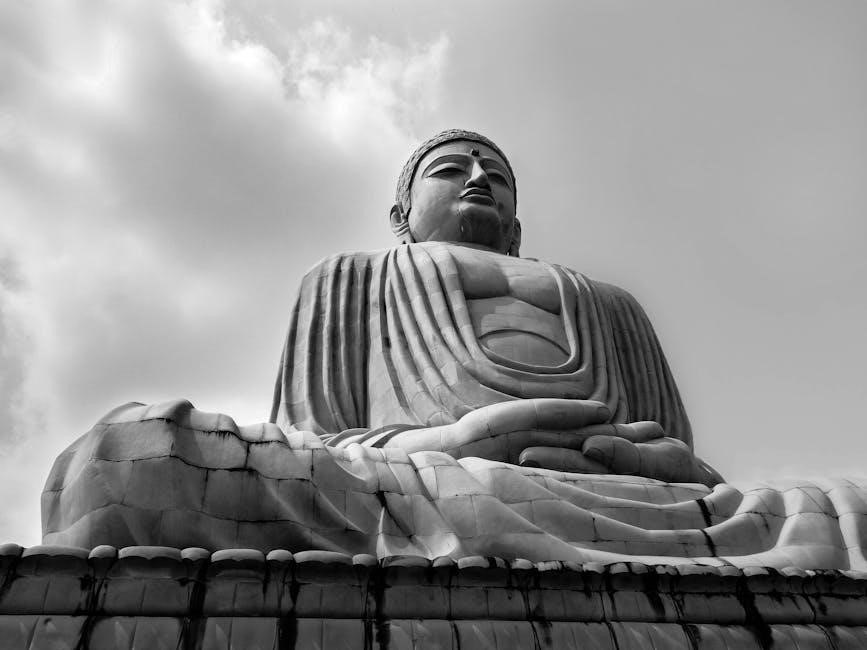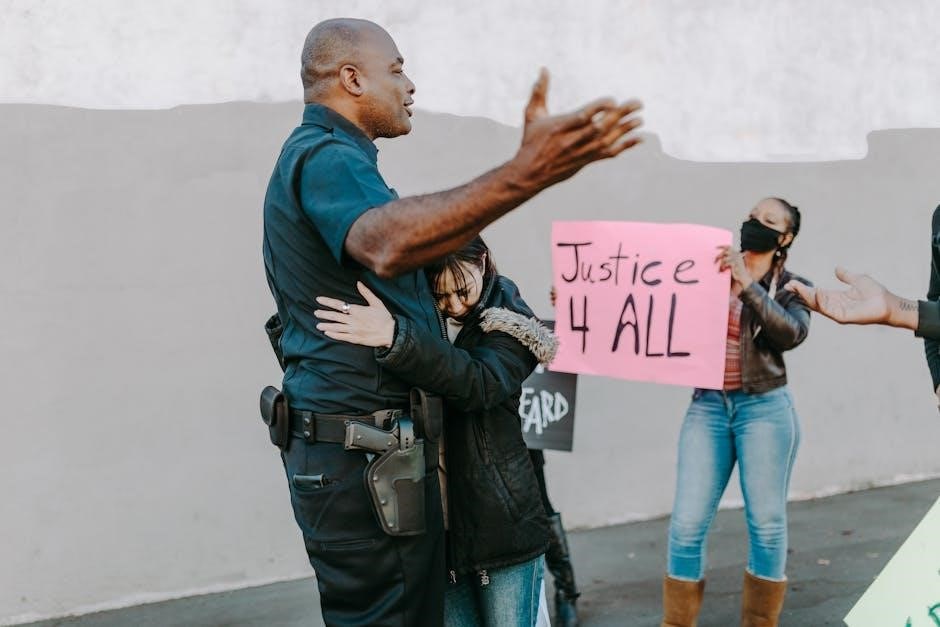The Great Law of Peace, or Gayanerekowa, is a foundational constitution of the Iroquois Confederacy, fostering peace, unity, justice, and equality among nations. Its principles have profoundly influenced modern governance and remain a cornerstone of Indigenous wisdom, emphasizing harmony with nature and collective decision-making. This sacred law continues to inspire global movements for democracy and reconciliation.
1.1 Definition and Overview
The Great Law of Peace, or Gayanerekowa, is a sacred constitution established by the Iroquois Confederacy to promote peace, justice, and equality among nations. It outlines principles of democracy, unity, and harmony with nature, serving as a moral and legal framework for governance. This ancient law remains a vital guide for resolving conflicts and fostering collective well-being.
1.2 Historical Context
The Great Law of Peace, established by Deganawida and the Haudenosaunee, originated in the late nineteenth century to unify the Five Nations. It created a democratic system, emphasizing peace and justice, and influenced the US Constitution. This foundational document laid the groundwork for the Iroquois Confederacy and its enduring principles of equality and shared governance.
1.3 Significance in Indigenous Governance
The Great Law of Peace is a cornerstone of Indigenous governance, emphasizing collective decision-making, representation, and justice. It established the Iroquois Confederacy as a model of democracy, inspiring modern governance systems. Its principles of equality, consensus, and harmony with nature remain vital, influencing Indigenous rights movements and global reconciliation efforts today.
The Structure of the Great Law of Peace
The Great Law of Peace established a democratic framework for the Iroquois Confederacy, uniting five nations under a system of shared governance, justice, and harmony. It outlined roles for leaders, councils, and ceremonies, ensuring collective decision-making and balance among its members.
2.1 The Five Nations Involved
The Great Law of Peace united the Mohawk, Oneida, Onondaga, Cayuga, and Seneca nations, forming the Iroquois Confederacy. These nations, each with distinct roles, came together to establish a democratic system of governance, ensuring peace and unity through shared principles and collective decision-making under the Great Law.
2.2 The Role of the Mohawk Lords
The Mohawk Lords served as foundational leaders and spiritual guides, entrusted with upholding the Great Law of Peace. They played a crucial role in mediating disputes and ensuring the Confederacy’s decisions aligned with the principles of peace, justice, and harmony, embodying the wisdom and integrity necessary for the Confederacy’s enduring stability.
2.3 The Confederate Council System
The Confederate Council System, established by the Great Law of Peace, served as a democratic framework for decision-making among the Five Nations. Composed of chiefs chosen for their wisdom, it ensured collective governance, emphasizing consensus and equality. This system promoted peaceful resolution of disputes and adherence to the law, fostering unity and strength within the Confederacy.
Key Principles of the Great Law of Peace
The Great Law of Peace emphasizes democracy, peace, justice, and equality, guiding collective decision-making. It promotes harmony with nature and unity among nations, fostering a balanced society.
3.1 Democracy and Representation
The Great Law of Peace established a democratic system where each nation in the Iroquois Confederacy had equal representation. Leaders, known as Mohawk Lords, were chosen by their people to ensure fair governance and collective decision-making. This model emphasized the importance of consensus and the voice of every community member in maintaining peace and unity.
3.2 Peace and Conflict Resolution
The Great Law of Peace emphasizes reconciliation and non-violence, providing structured methods for resolving disputes. It encourages open dialogue, forgiveness, and restoration of harmony among nations. The planting of the Great Tree of Peace symbolizes unity and the burying of weapons, fostering a culture of enduring peace and cooperation.
3.3 The Laws of Nature and Their Role
Deganawida taught that harmony with nature is central to peace. The Great Law reflects this by aligning human governance with natural principles. It emphasizes sustainability and respect for the land, ensuring decisions benefit future generations and maintain balance within the environment and society.
Ceremonies and Rituals in the Great Law of Peace
Ceremonial practices, such as the planting of the Great Tree of Peace, symbolize unity and foster peace. Rituals like wampum ceremonies strengthen commitments to harmony and mutual respect.
4.1 The Planting of the Great Tree of Peace
The Great Tree of Peace symbolizes unity and strength, planted to signify the end of conflict. Its roots spread in all directions, embracing all nations under the shared vision of harmony and collective prosperity, reflecting the enduring principles of the Great Law of Peace.
4.2 The Use of Wampum in Ceremonies
Wampum, made from shells, is central to ceremonies, symbolizing peace and unity. It records agreements, laws, and history. During rituals, wampum belts are displayed, recounting the Great Law of Peace. This sacred practice ensures accountability and remembrance, embedding the principles of harmony and justice in the collective memory of the Iroquois Confederacy.
4.3 Festivals and Rites Supporting Peace
Seasonal festivals honor the Great Law of Peace, fostering unity and gratitude. Ceremonies like the Midwinter Ceremony renew commitments to peace and harmony. These rites strengthen communal bonds, ensuring the principles of the Great Law remain vibrant and guiding forces in the lives of the Iroquois Confederacy and its people.

The Influence of the Great Law of Peace on the US Constitution
The Great Law of Peace inspired democratic principles in the US Constitution, particularly through its emphasis on representation and collective decision-making, influencing the Founding Fathers’ framework for governance.
5.1 Similarities in Democratic Principles
The Great Law of Peace and the US Constitution share key democratic principles, including representation, checks and balances, and the idea of a republic. Both systems emphasize fairness, justice, and the consent of the governed, with elected representatives accountable to the people. These parallels reflect the Iroquois Confederacy’s influence on early American governance structures.
5.2 The Role of the Iroquois in American History
The Iroquois Confederacy played a pivotal role in shaping early American governance, introducing concepts of representative democracy and federalism. Their system, based on the Great Law of Peace, influenced colonial leaders and later the U.S. Constitution. The Iroquois model of unity and consensus-building remains a cornerstone of American political history and Indigenous contributions to democracy.
5.3 Modern Recognition of Its Impact
The Great Law of Peace is widely acknowledged today for its enduring influence on democracy and governance. It is celebrated in educational resources, historical documents, and contemporary Indigenous rights movements. Its principles of unity and justice continue to inspire global efforts in conflict resolution and equitable governance, ensuring its legacy endures in modern times.

The Great Law of Peace in Modern Times
The Great Law of Peace remains a vital guide for contemporary governance and Indigenous rights, inspiring movements for justice and unity worldwide today.
6.1 Relevance to Contemporary Indigenous Issues
The Great Law of Peace addresses modern Indigenous challenges by promoting unity, environmental stewardship, and self-governance. Its principles guide efforts to resolve land disputes, protect cultural heritage, and assert sovereignty, offering timeless solutions to contemporary struggles faced by Native communities in preserving their identity and rights.
6.2 Challenges in Preserving the Law
Preserving the Great Law of Peace faces challenges like cultural erosion, limited awareness, and the complexities of adapting oral traditions to modern society. Efforts to digitize and educate through PDF resources help, but maintaining its spiritual integrity and relevance remains a significant task for Indigenous communities striving to honor their heritage.
6.3 Efforts to Revitalize Its Teachings
Efforts to revive the Great Law of Peace include educational initiatives, cultural workshops, and digital archiving. PDF resources like lesson plans from nhd.org/RevIdeals and historical documents are widely used. Communities organize festivals and rites to honor its principles, while leaders emphasize its relevance in modern governance and global reconciliation through peaceful coexistence and nature-based wisdom.

The Role of Deganawida and the Founding of the Great Law
Deganawida, a visionary leader, founded the Great Law of Peace, teaching unity, justice, and harmony with nature. His wisdom established the Iroquois Confederacy, enduring to this day.
7.1 The Story of Deganawida
Deganawida, a wise spiritual leader, brought the vision of the Great Law of Peace to the Iroquois nations, ending centuries of conflict. His teachings emphasized unity, justice, and harmony with nature, inspiring the creation of the Iroquois Confederacy. Deganawida’s wisdom laid the foundation for a democratic system that continues to influence global governance and peace efforts today.
7.2 His Teachings on Peace and Unity
Deganawida’s teachings on peace and unity were central to the Great Law of Peace. He promoted justice, equality, and harmony with nature, uniting the five Iroquois nations under a shared vision. His principles established the Iroquois Confederacy, inspiring democratic governance and fostering enduring peace and cooperation, leaving a lasting legacy in global peace efforts.
7.3 His Legacy in Modern Times
Deganawida’s legacy endures as a symbol of unity and peace. His teachings inspire modern governance, education, and global movements. The Great Law of Peace, which he founded, continues to influence contemporary Indigenous rights and democratic principles, ensuring his vision of harmony remains relevant and transformative in today’s world.

The Great Law of Peace and the Iroquois Confederacy
The Great Law of Peace established the Iroquois Confederacy, uniting five nations under democratic principles of peace, justice, and equality, ensuring harmony and collective prosperity.
8.1 The Confederacy’s Structure and Function
The Iroquois Confederacy, structured under the Great Law of Peace, operated as a democratic alliance of nations, with decision-making authority vested in clan mothers and chiefs. This system ensured collective governance, fostering peace and unity among member nations through a council-based approach, balancing individual and communal rights for sustainable harmony.
8.2 How the LawGuides Decision-Making
8.2 How the Law Guides Decision-Making
The Great Law of Peace establishes a consensus-based decision-making process within the Confederate Council. Chiefs and clan mothers deliberate to ensure collective well-being, guided by principles of equality and justice. Wampum records decisions, symbolizing transparency and accountability. This system reflects democratic ideals, influencing modern governance and emphasizing harmony among diverse voices.
8.3 Case Studies of Its Application
The Great Law of Peace has been applied in resolving inter-tribal conflicts and fostering unity. Historical examples include the Iroquois Confederacy addressing disputes among the Five Nations. Modern applications involve Indigenous communities using its principles to support environmental sustainability and cultural preservation, demonstrating its enduring relevance in promoting harmony and justice.
The Great Law of Peace and Indigenous Rights
The Great Law of Peace promotes justice, equality, and rights for Indigenous peoples, inspiring movements for self-determination and cultural preservation, both locally and internationally.
9.1 Its Impact on Native American Movements
The Great Law of Peace has profoundly influenced Native American movements by promoting democracy, justice, and unity. Its principles inspired self-determination efforts, fostering cultural preservation and sovereignty. Historical documents highlight its role in shaping Indigenous rights, encouraging collective action and resilience among Native communities, ensuring its teachings remain vital in modern advocacy.
9.2 International Recognition of Its Principles
The Great Law of Peace is globally acclaimed for its democratic ideals and commitment to harmony. Its principles are studied worldwide as a model for conflict resolution. International recognition highlights its universal relevance, with organizations adopting its teachings to promote peace and justice. This Indigenous wisdom continues to inspire global movements for equality and unity.
9.3 Challenges in Implementing Its Teachings Globally
Adapting the Great Law of Peace globally faces challenges like cultural differences and resistance to Indigenous governance. Modern legal systems often conflict with its communal focus. Additionally, limited awareness and historical marginalization hinder its widespread adoption. Efforts to revitalize its teachings must address these barriers to ensure its universal application and acceptance in diverse societies.

Educational Resources and the Great Law of Peace PDF
Educational resources on the Great Law of Peace are widely available in PDF formats, including lesson plans, historical documents, and guides for comprehensive understanding and teaching.
10.1 Availability of PDF Materials
PDF materials on the Great Law of Peace are accessible through various online platforms, including educational websites and historical archives; These resources provide detailed insights into the law’s principles, historical context, and modern applications. Many PDFs offer lesson plans, guides, and primary documents, serving as invaluable tools for educators, researchers, and enthusiasts seeking to explore this foundational text.
10.2 Lesson Plans and Educational Tools
Lesson plans and educational tools related to the Great Law of Peace are widely available in PDF formats, offering interactive activities, discussion guides, and historical context. These resources help educators teach the principles of peace, democracy, and unity, making them accessible for students and learners of all levels to explore and understand this foundational document.
10.3 Online Archives and Historical Documents
Online archives provide access to historical documents, including the Great Law of Peace PDF, offering insights into its origins and principles. Digital libraries and historical societies host Wampum belts, treaties, and transcripts, preserving the legacy of the Iroquois Confederacy. These resources are invaluable for researchers and educators seeking authentic historical content for study and reference.
The Great Law of Peace, as detailed in the PDF, stands as a timeless blueprint for harmony, unity, and justice, inspiring global governance and reconciliation efforts.
11.1 Summary of Key Points
The Great Law of Peace, or Gayanerekowa, is a foundational Indigenous constitution promoting peace, justice, equality, and unity. It established a democratic system, inspiring global governance. Key principles include democracy, conflict resolution, and harmony with nature. Ceremonies like the Tree of Peace planting and wampum use reinforce its teachings. Its influence extends to the US Constitution and modern Indigenous rights movements, ensuring its enduring legacy.
11.2 The Enduring Legacy of the Great Law
The Great Law of Peace, or Gayanerekowa, endures as a timeless wisdom, guiding principles of peace, unity, justice, and equality. Its influence spans centuries, shaping historical milestones and global governance. Today, it inspires movements for justice, equality, and sustainability, proving its relevance in modern times as a blueprint for humanity’s collective future.
11.3 Final Thoughts on Its Importance
The Great Law of Peace remains a cornerstone of Indigenous wisdom, offering timeless principles of unity, justice, and harmony with nature. Its influence on global governance and democracy is undeniable, inspiring movements for equality and reconciliation. As a living document, it continues to guide humanity toward peace and collective prosperity, ensuring its relevance for future generations.